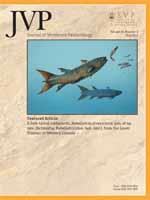An unusual fork-tailed coelacanth from the Lower Triassic Sulphur Mountain Formation of British Columbia, Canada, marks the first considerable departure in actinistian body form since the Mississippian Period. Rebellatrix divaricerca, gen. et sp. nov., is unique among coelacanths in its possession of a bifurcated caudal fin, reduced segmentation of fin rays, and fusion of caudal fin elements. Parsimony analysis of a character-taxon matrix of 109 characters and 29 taxa recovered R. divaricerca as sister taxon to Latimerioidei. The family Rebellatricidae is erected to include only R. divaricerca. This novel body shape of the new coelacanth raises questions about the idea that coelacanths were morphologically static following the Mississippian. Rebellatrix divaricerca also emphasizes the morphological diversity of coelacanths during the Early Triassic, a time when species diversity of coelacanths was also highest. The slender, fork-tailed body form suggests fast swimming and an active lifestyle, unique among known fossil and extant coelacanths.
How to translate text using browser tools
1 May 2012
A Fork-Tailed Coelacanth, Rebellatrix divaricerca, gen. et sp. nov. (Actinistia, Rebellatricidae, fam. nov.), from the Lower Triassic of Western Canada
Andrew J. Wendruff,
Mark V. H. Wilson
ACCESS THE FULL ARTICLE

Journal of Vertebrate Paleontology
Vol. 32 • No. 3
May 2012
Vol. 32 • No. 3
May 2012




